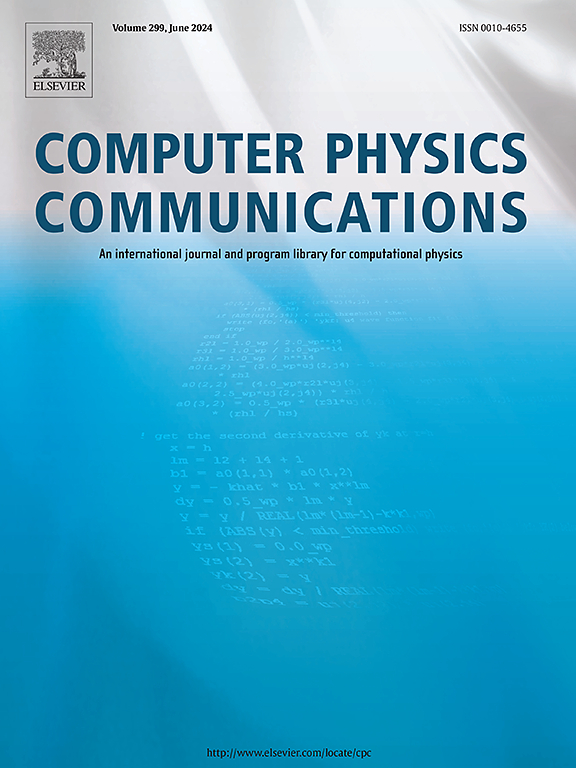基于量子光学的碱金属原子光学布洛赫速率方程求解工具。Julia中的jl包
IF 3.4
2区 物理与天体物理
Q1 COMPUTER SCIENCE, INTERDISCIPLINARY APPLICATIONS
引用次数: 0
摘要
光学布洛赫方程(obe)用于计算原子系综密度矩阵在哈密顿量作用下的演化。一种常见的情况是具有超精细结构的原子与外部磁场和激光辐射相互作用。当激光辐射的谱线宽度远大于跃迁的自然谱线宽度,模间距远大于自然谱线宽度,谱线宽度远大于密度矩阵的特征演化时间时,光场辐射可以简化为塞曼相干的速率方程。我们提出了一个基于量子光学的工具来求解这些速率方程。jl包中的Julia语言。使用这些工具使代码比以前的C/ c++实现更具可读性,但几乎同样快速且更容易并行化。该工具包包括计算碱金属原子密度矩阵在外部磁场存在下的稳态解和暴露在任意偏振和传播方向的泵浦激光束下的函数。基于此密度矩阵,该工具包提供了确定任意偏振和方向的荧光强度以及弱探测光束的吸收,以及任意偏振和传播方向的功能。它还可以根据计算出的密度矩阵绘制出原子的电子角动量分布图。该工具包可在Github上获得,并已通过将其结果与用C/ c++编写的遗留代码和实验测量进行比较来验证。作为一个测试用例,我们将展示如何使用该工具包来优化一个简单的原子磁力计。程序摘要程序标题:光学块方程。jlCPC库链接到程序文件:https://doi.org/10.17632/bbjh8bdcgj.1Licensing规定:mit编程语言:julia补充材料:GitHub floriansLU/ optics blochequations。问题的性质:碱原子与辐射和磁场的相互作用。求解方法:数值求解稳态条件下的光学Bloch速率方程。附加评论包括限制和不寻常的功能:框架是基于量子光学。Jl包并计算在存在外部磁场的原子系综中泵浦光束的荧光或探针光束的吸收。该程序解决的不是完整的光学布洛赫方程,而是可以简化为塞曼相干速率方程的限制情况,这在以下条件下是可能的:•激光辐射的谱线宽度Δω远大于跃迁的自然线宽Γ (Δω比Γ);•模间距Δω远大于自然线宽(Δω≪Γ;•谱线宽度远大于密度矩阵的特征演化时间Γp (Δω ~ Γp)。然而,这些对塞曼相干速率方程的一般限制不适用于稳态条件,而这正是该程序旨在解决的问题。所以为了这个程序的目的,唯一的限制是稳态条件。本文章由计算机程序翻译,如有差异,请以英文原文为准。
A Toolkit for solving the Optical Bloch Rate Equations in alkali metal atoms based on the QuantumOptics.jl package in Julia
The Optical Bloch Equations (OBEs) are useful for calculating the evolution of the density matrix of an atomic ensemble under the action of some Hamiltonian. A common situation concerns atoms with hyperfine structure that interact with an external magnetic field and laser radiation. When the spectral linewidth of the laser radiation is much larger than the natural linewidth of the transition, the mode spacing is much smaller than the natural linewidth, and the spectral linewidth is much larger than the characteristic evolution time of the density matrix, the OBEs can be reduced to rate equations for Zeeman coherences. We present a toolkit for solving these rate equations based on the QuantumOptics.jl package in the Julia language. Using these tools makes the code much more readable than previous implementations in C/C++, but almost as fast and easier to parallelize. The toolkit includes functions for calculating the steady-state solution of density matrix of alkali metal atoms in the presence of an external magnetic field and exposed to a pump laser beam of arbitrary polarization and propagation direction. Based on this density matrix, the toolkit offers functions to determine the fluorescence intensity of arbitrary polarization and direction as well as the absorption of a weak probe beam, also of arbitrary polarization and propagation direction. It can also produce a plot of the electronic angular momentum distribution of the atom based on the calculated density matrix. The toolkit is available on Github and has been validated by comparing its results to legacy code written in C/C++ and experimental measurements. As a test case, we show how the toolkit can be used to optimize a simple atomic magnetometer.
Program summary
Program Title: OpticalBlochEquations.jl
CPC Library link to program files: https://doi.org/10.17632/bbjh8bdcgj.1
Licensing provisions: MIT
Programming language: Julia
Supplementary material: GitHub floriansLU/OpticalBlochEquations.jl
Nature of problem: Interaction of alkali atoms with radiation and magnetic fields.
Solution method: Numerically solving the Optical Bloch Rate Equations in steady-state conditions.
Additional comments including restrictions and unusual features: The framework is based on the QuantumOptics.jl package and calculates fluorescence of a pump beam or absorption of a probe beam in an atomic ensemble in the presence of an external magnetic field.
The program solves not the full Optical Bloch Equations, but the restricted case when they can be reduced to rate equations for Zeeman coherences, which is possible under the following conditions:
- •the spectral linewidth of the laser radiation Δω is much larger than the natural linewidth of the transition Γ ();
- •the mode spacing δω is much smaller than the natural linewidth (; and
- •the spectral linewidth is much larger than the characteristic evolution time of the density matrix ().
求助全文
通过发布文献求助,成功后即可免费获取论文全文。
去求助
来源期刊

Computer Physics Communications
物理-计算机:跨学科应用
CiteScore
12.10
自引率
3.20%
发文量
287
审稿时长
5.3 months
期刊介绍:
The focus of CPC is on contemporary computational methods and techniques and their implementation, the effectiveness of which will normally be evidenced by the author(s) within the context of a substantive problem in physics. Within this setting CPC publishes two types of paper.
Computer Programs in Physics (CPiP)
These papers describe significant computer programs to be archived in the CPC Program Library which is held in the Mendeley Data repository. The submitted software must be covered by an approved open source licence. Papers and associated computer programs that address a problem of contemporary interest in physics that cannot be solved by current software are particularly encouraged.
Computational Physics Papers (CP)
These are research papers in, but are not limited to, the following themes across computational physics and related disciplines.
mathematical and numerical methods and algorithms;
computational models including those associated with the design, control and analysis of experiments; and
algebraic computation.
Each will normally include software implementation and performance details. The software implementation should, ideally, be available via GitHub, Zenodo or an institutional repository.In addition, research papers on the impact of advanced computer architecture and special purpose computers on computing in the physical sciences and software topics related to, and of importance in, the physical sciences may be considered.
 求助内容:
求助内容: 应助结果提醒方式:
应助结果提醒方式:


